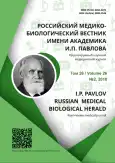Evaluation of biological effectiveness of amino acid mixture as potential stimulator of synthetic processes in skeletal muscles
- Authors: Stogov M.V.1, Kireeva E.A.1
-
Affiliations:
- The Russian Ilizarov Scientific Center for Restorative Traumatologyand Orthopaedics
- Issue: Vol 26, No 2 (2018)
- Pages: 213-221
- Section: Original study
- URL: https://journals.rcsi.science/pavlovj/article/view/9093
- DOI: https://doi.org/10.23888/PAVLOVJ2018262213-221
- ID: 9093
Cite item
Abstract
Background. The ability of certain amino acids to stimulate anabolic processes in skeletal muscles has been proved by fundamental research, which makes it important to search for effective agents based on amino acids for stimulation of synthetic processes in skeletal muscles.
Aim. To study the effect of oral administration of the original amino acid mixture (Larginine, Lmethionine, Lleucine, Lisoleucine) on protein, lipid and carbohydrate metabolism in skeletal muscles and liver of CBA male mice.
Material and Methods. Two series of experiments were performed. In the first series (n=36), the animals were divided into three groups. In group 1 (n = 12), the mice received a diet balanced in protein and carbohydrates for two months. The animals of group 2 (n=12) were kept on a carbohydrate, proteindepleted isocaloric diet, in which wheat gliadin served as the protein source. Mice of group 3 (n=12) were kept on a diet similar to the second group, in which deficit of protein was compensated for with the tested mixture of Lamino acids. In the animals of the second series (n=36) acute liver failure was modeled by a single intraperitoneal injection of 20% carbon tetrachloride solution (CTC) in olive oil. Three days after the injection of CTC, all animals of the second series were randomly divided into three groups, depending on the received diet.
Results. The results of the first series of experiments showed that compensation for protein deficiency with amino acid mixture reliably prevented excessive buildup of glycogen in muscles, led to a decrease in lipids in tissue, and also prevented reduction in the level of muscle protein. The results of the second series of experiments showed that intake of the amino acid mixture prevented loss of protein in muscles and supported the proteinsynthetic function of the liver.
Conclusion. The study demonstrated that the tested mixture, when taken orally, can prevent disorders of proteincarbohydratelipid ratio in the muscles.
Keywords
Full Text
##article.viewOnOriginalSite##About the authors
Maxim V. Stogov
The Russian Ilizarov Scientific Center for Restorative Traumatology and Orthopaedics
Author for correspondence.
Email: stogo_off@list.ru
ORCID iD: 0000-0001-8516-8571
SPIN-code: 9345-8300
Grand PhD in Biological sciences, Associate Professor, Leading Researcher of Laboratory of Biochemistry
Russian Federation, 6, M.Ulianova St., Kurgan, 640005Elena A. Kireeva
The Russian Ilizarov Scientific Center for Restorative Traumatology and Orthopaedics
Email: stogo_off@list.ru
ORCID iD: 0000-0002-1006-5217
SPIN-code: 9598-0838
PhD in Biological sciences, Senior Researcher of Laboratory of Biochemistry
Russian Federation, 6, M.Ulianova St., Kurgan, 640005References
- Lieber RL, Jacks TM, Mohler RL, et al. Growth hormone secretagogue increases muscle strength during remobilization after canine hindlimb immobilization. J Orthop Res. 1997; 15(4):51927.
- Schertzer JD, Ryall JD, Lynch GS. Systemic administration of IGFI enhances oxidative status and reduces contractioninduced injury in skeletal muscles of mdx dystrophic mice. Am J Physiol Endocrinol Metab. 2006;291(3): E499E505. doi: 10.1152/ajpendo.00101.2006
- Hamel FG, Upward JL, Siford GL, et al. Inhibition of proteasome activity by selected amino acids. Metabolism. 2003;52(7):8104.
- Levi RS, Sanderson IR. Dietary regulation of gene expression. Curr Opin Gastroenterol. 2004;20(2):13942.
- Zhou P, Zhang L, Li J, et al. Effects of dietary crude protein levels and cysteamine supplementation on protein synthetic and degradative signaling in skeletal muscle of finishing pigs. PLoS One. 2015;10(9):e0139393. doi: 10.1371/ journal.pone.0139393
- Duan Y, Duan Y, Li F, et al. Effects of supplementation with branchedchain amino acids to lowprotein diets on expression of genes related to lipid metabolism in skeletal muscle of growing pigs. Amino Acids. 2016;48(9):213144. doi: 10.1007/s0072601622232
- Zheng L, Wei H, Cheng C, et al. Supplementation of branchedchain amino acids to a reducedprotein diet improves growth performance in piglets: involvement of increased feed intake and direct muscle growthpromoting effect. Br J Nutr. 2016;115(12): 223645. doi: 10.1017/S0007114516000842
- Duan Y, Li F, Li Y, et al. The role of leucine and its metabolites in protein and energy metabolism. Amino Acids. 2016;48(1):4151. doi: 10.1007/s0072601520671
- Holecek M, Sispera L. Effects of arginine supplementation on amino acid profiles in blood and tissues in fed and overnightfasted rats. Nutrients. 2016;8(4):206. doi: 10.3390/nu8040206
- Welle S, Bhatt K, Pinkert CA. Myofibrillar protein synthesis in myostatindeficient mice. Am J Physiol Endocrinol Metab. 2006;290(3): 40915. doi: 10.1152/ajpendo.00433.2005
- Wernerman J. Clinical use of glutamine supplementation. J Nutr. 2008;138(10):20404. doi: 10.1093/jn/138.10.2040S
- Hosford AD, Hergenreder JE, Kim JK, et al. Effects of supplemental lysine and methionine with zilpaterol hydrochloride on feedlot performance, carcass merit, and skeletal muscle fiber characteristics in finishing feedlot cattle. J Anim Sci. 2015;93(9):453244. doi:10.2527/ jas.20159047
- Dabrowski K, Terjesen BF, Zhang Y, et al. A concept of dietary dipeptides: a step to resolve the problem of amino acid availability in the early life of vertebrates. J Exp Biol. 2005; 208(15):288594. doi: 10.1242/jeb.01689
- Severin SE, Solov'eva GA, editors. Praktikum po biokhimii. Moscow: Izdatelstvo MGU; 1989. (In Russ).
- Stogov MV, Luneva SN, Tkachuk EA., et al. Interorganic relationship of energy metabolism substrates in mice for skeletal trauma. Genij Ortopedii. 2010;(3):402. (In Russ).
Supplementary files












